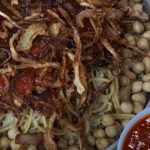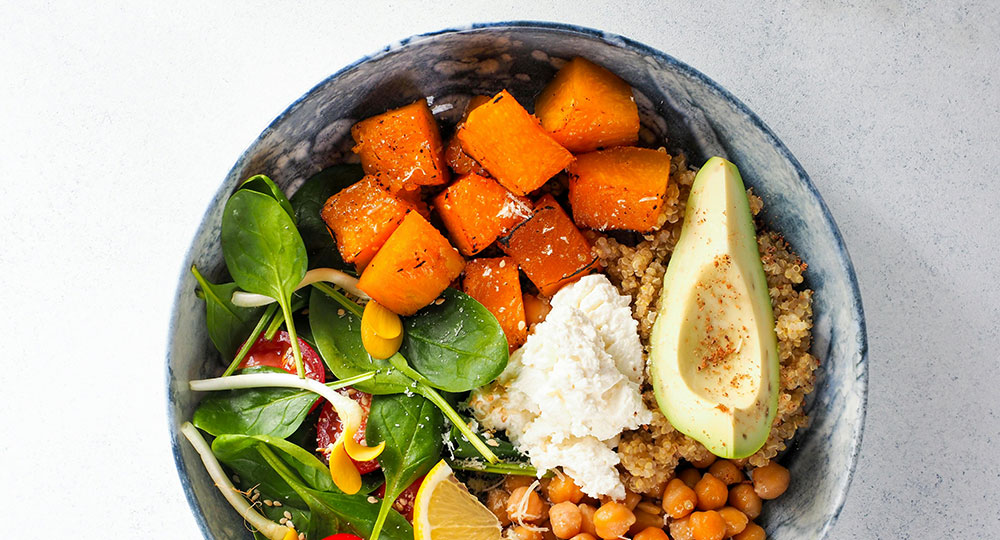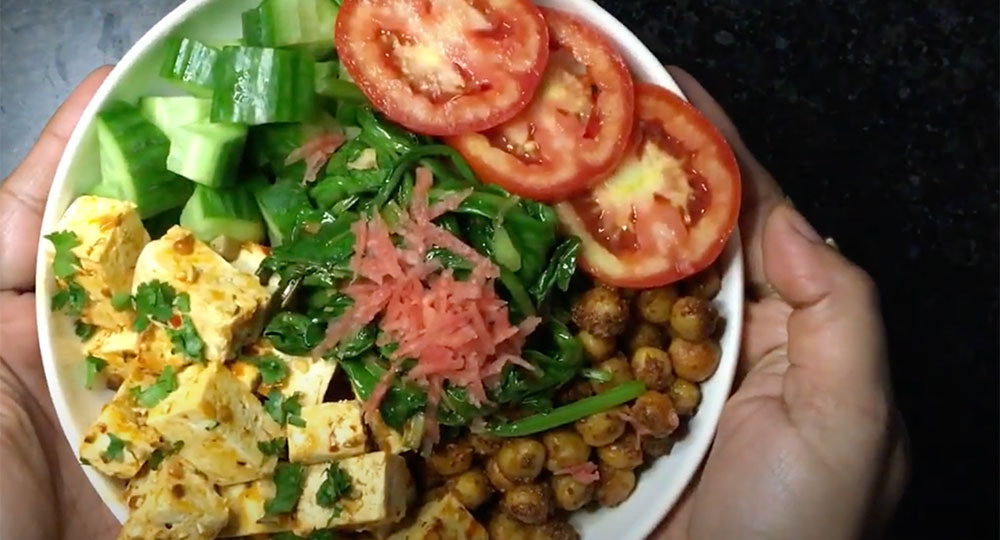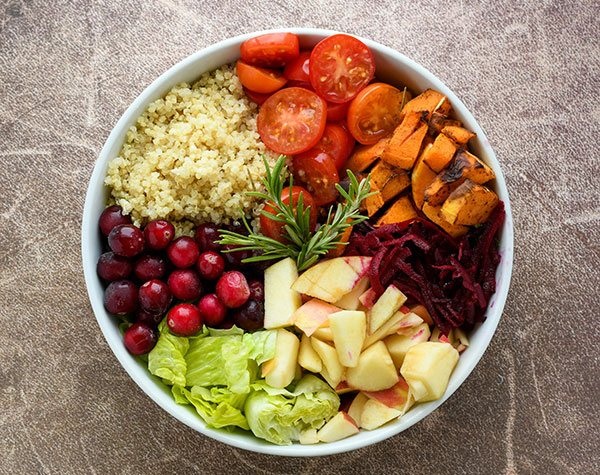
Egyptian Koshary
September 4, 2024
Tabbouleh: A Fresh Taste of the Middle East
October 27, 2024
Egyptian Koshary
September 4, 2024
Tabbouleh: A Fresh Taste of the Middle East
October 27, 2024
The Vegetarian Buddha Bowl
A Nourishing, Customizable Meal
In recent years, the concept of the "Buddha Bowl" has become increasingly popular, particularly among those seeking healthy and satisfying vegetarian meals. The beauty of a Buddha Bowl lies in its simplicity and versatility. This one-bowl meal can be packed with a variety of nutrient-dense ingredients that offer a well-balanced, plant-based diet. For those looking to find vegetarian recipes that are both wholesome and delicious, the Vegetarian Buddha Bowl is a perfect choice.
20 Mins
Easy
Serves 2
What is a Buddha Bowl?
The name "Buddha Bowl" originates from the idea of a bowl so full that it has a rounded "belly," reminiscent of the traditional depictions of Buddha. It typically consists of a mix of whole grains, vegetables, and plant-based protein, arranged in a way that offers a visually appealing and nutritionally balanced meal. The ingredients are often served cold, but warm versions are also popular. The key aspect of this dish is the wide variety of components, allowing for endless customization based on personal preferences and what is seasonally available.
The Nutritional Powerhouse
When people search to find vegetarian recipes that offer both variety and nutrition, Buddha Bowls stand out. These bowls combine all the essential macronutrients in one meal, ensuring that you get a healthy mix of carbohydrates, proteins, and fats. A typical Buddha Bowl starts with a base of whole grains, such as brown rice, quinoa, or barley. Whole grains provide fiber, essential vitamins, and minerals that contribute to sustained energy throughout the day.
The next essential component is vegetables, which can include both raw and cooked options. Roasted vegetables like sweet potatoes, cauliflower, and Brussels sprouts are often used, alongside fresh greens such as spinach, kale, or arugula. These ingredients are rich in antioxidants, vitamins, and minerals, promoting overall health and well-being.
For protein, plant-based options like chickpeas, lentils, or tofu are commonly used. Adding legumes or tofu provides a source of complete protein, making it easy for vegetarians to meet their daily protein requirements. Healthy fats are often included through ingredients like avocado, nuts, seeds, or a drizzle of tahini or olive oil. These healthy fats help in the absorption of fat-soluble vitamins and contribute to a feeling of fullness.

find vegetarian recipes like the Buddha Bowl
Versatility and Customization
One of the primary reasons people find vegetarian recipes like the Buddha Bowl so appealing is the freedom to customize the dish to suit individual tastes and dietary preferences. Whether you prefer a Mediterranean flavor profile with hummus, olives, and roasted vegetables, or an Asian-inspired bowl with edamame, tofu, and a sesame-ginger dressing, the possibilities are endless.
The choice of dressing also plays a crucial role in tying together the various flavors of a Buddha Bowl. From a creamy tahini-based dressing to a light lemon vinaigrette or spicy peanut sauce, the dressing elevates the dish, adding an extra layer of flavor and richness.
Easy to Prepare and Meal-Prep Friendly
For those who often search to find vegetarian recipes that are quick and easy to prepare, the Buddha Bowl offers convenience without compromising on nutrition or flavor. Many of the components can be prepared in advance, such as roasting vegetables or cooking grains, making it a great option for meal prep. This way, you can assemble your bowl in minutes, whether for lunch, dinner, or a satisfying post-workout meal.
Additionally, it is an excellent way to reduce food waste, as you can easily incorporate leftover vegetables, grains, and protein sources from previous meals. This makes the Buddha Bowl not only eco-friendly but also budget-friendly.
A Sustainable Choice
Opting for more plant-based meals like the Vegetarian Buddha Bowl contributes to a more sustainable and environmentally friendly lifestyle. By choosing plant-based proteins over animal-based ones, you reduce your carbon footprint, conserve water, and help alleviate the environmental stress caused by industrial farming. Many individuals find vegetarian recipes not only for health reasons but also to support a more ethical and sustainable food system.
Conclusion
The Vegetarian Buddha Bowl exemplifies how simple, plant-based ingredients can come together to create a nutrient-packed, flavorful meal. With its balance of whole grains, fresh vegetables, plant-based protein, and healthy fats, it’s a great option for anyone looking to find vegetarian recipes that offer both nutrition and versatility. Whether you're a seasoned vegetarian or simply trying to incorporate more plant-based meals into your diet, the Buddha Bowl is a perfect go-to option. It’s more than just a meal; it’s a celebration of colors, flavors, and wholesome ingredients, all in one bowl.
How to Cook a Vegetarian Buddha Bowl
Cooking a Vegetarian Buddha Bowl is all about creating a balanced, nutrient-packed meal by combining a variety of ingredients. Here’s a simple guide to making a delicious Buddha Bowl at home:
Ingredients (serves 2)
For the Base:
- 1 cup cooked quinoa (or other grains like brown rice, farro, or couscous)
For the Vegetables:
- 1 sweet potato, peeled and cubed
- 1 cup broccoli florets
- 1 carrot, sliced
- 1 tablespoon olive oil
- Salt and pepper to taste
For the Protein:
- 1 cup chickpeas (cooked or canned, rinsed and drained)
- 1 teaspoon cumin
- 1/2 teaspoon paprika
- 1 tablespoon olive oil
For Healthy Fats:
- 1 avocado, sliced
- 2 tablespoons tahini or peanut butter
For Additional Toppings:
- Fresh spinach or arugula
- A handful of mixed seeds (pumpkin, sunflower, etc.)
- Lemon wedges for garnish
For the Dressing:
- 2 tablespoons tahini
- 1 tablespoon lemon juice
- 1 tablespoon olive oil
- 1 teaspoon maple syrup or honey
- 1 clove garlic, minced
- Water (to thin, as needed)
- Salt and pepper to taste
Preparation Steps:

